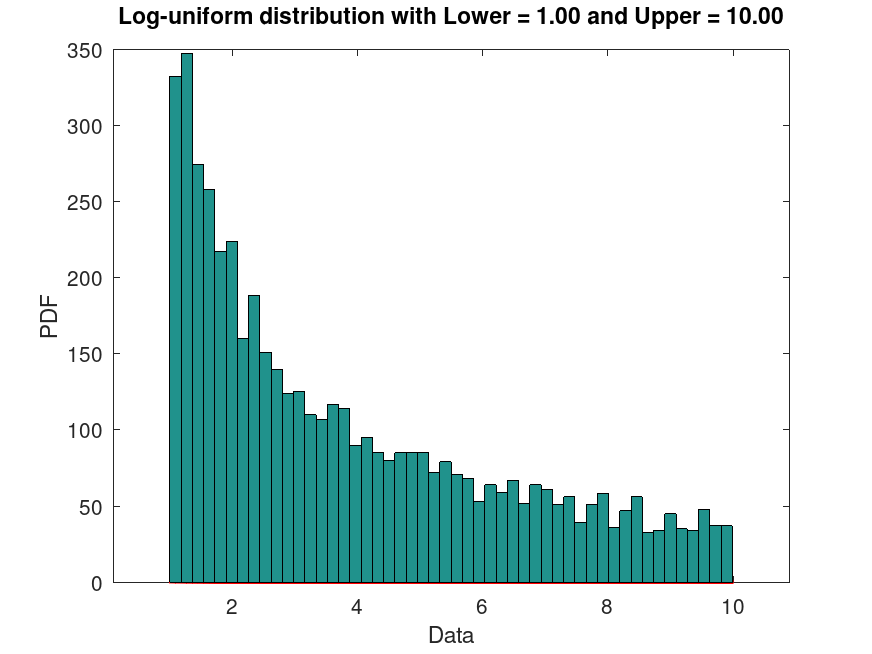Categories &
Functions List
- BetaDistribution
- BinomialDistribution
- BirnbaumSaundersDistribution
- BurrDistribution
- ExponentialDistribution
- ExtremeValueDistribution
- GammaDistribution
- GeneralizedExtremeValueDistribution
- GeneralizedParetoDistribution
- HalfNormalDistribution
- InverseGaussianDistribution
- LogisticDistribution
- LoglogisticDistribution
- LognormalDistribution
- LoguniformDistribution
- MultinomialDistribution
- NakagamiDistribution
- NegativeBinomialDistribution
- NormalDistribution
- PiecewiseLinearDistribution
- PoissonDistribution
- RayleighDistribution
- RicianDistribution
- tLocationScaleDistribution
- TriangularDistribution
- UniformDistribution
- WeibullDistribution
- betafit
- betalike
- binofit
- binolike
- bisafit
- bisalike
- burrfit
- burrlike
- evfit
- evlike
- expfit
- explike
- gamfit
- gamlike
- geofit
- gevfit_lmom
- gevfit
- gevlike
- gpfit
- gplike
- gumbelfit
- gumbellike
- hnfit
- hnlike
- invgfit
- invglike
- logifit
- logilike
- loglfit
- logllike
- lognfit
- lognlike
- nakafit
- nakalike
- nbinfit
- nbinlike
- normfit
- normlike
- poissfit
- poisslike
- raylfit
- rayllike
- ricefit
- ricelike
- tlsfit
- tlslike
- unidfit
- unifit
- wblfit
- wbllike
- betacdf
- betainv
- betapdf
- betarnd
- binocdf
- binoinv
- binopdf
- binornd
- bisacdf
- bisainv
- bisapdf
- bisarnd
- burrcdf
- burrinv
- burrpdf
- burrrnd
- bvncdf
- bvtcdf
- cauchycdf
- cauchyinv
- cauchypdf
- cauchyrnd
- chi2cdf
- chi2inv
- chi2pdf
- chi2rnd
- copulacdf
- copulapdf
- copularnd
- evcdf
- evinv
- evpdf
- evrnd
- expcdf
- expinv
- exppdf
- exprnd
- fcdf
- finv
- fpdf
- frnd
- gamcdf
- gaminv
- gampdf
- gamrnd
- geocdf
- geoinv
- geopdf
- geornd
- gevcdf
- gevinv
- gevpdf
- gevrnd
- gpcdf
- gpinv
- gppdf
- gprnd
- gumbelcdf
- gumbelinv
- gumbelpdf
- gumbelrnd
- hncdf
- hninv
- hnpdf
- hnrnd
- hygecdf
- hygeinv
- hygepdf
- hygernd
- invgcdf
- invginv
- invgpdf
- invgrnd
- iwishpdf
- iwishrnd
- jsucdf
- jsupdf
- laplacecdf
- laplaceinv
- laplacepdf
- laplacernd
- logicdf
- logiinv
- logipdf
- logirnd
- loglcdf
- loglinv
- loglpdf
- loglrnd
- logncdf
- logninv
- lognpdf
- lognrnd
- mnpdf
- mnrnd
- mvncdf
- mvnpdf
- mvnrnd
- mvtcdf
- mvtpdf
- mvtrnd
- mvtcdfqmc
- nakacdf
- nakainv
- nakapdf
- nakarnd
- nbincdf
- nbininv
- nbinpdf
- nbinrnd
- ncfcdf
- ncfinv
- ncfpdf
- ncfrnd
- nctcdf
- nctinv
- nctpdf
- nctrnd
- ncx2cdf
- ncx2inv
- ncx2pdf
- ncx2rnd
- normcdf
- norminv
- normpdf
- normrnd
- plcdf
- plinv
- plpdf
- plrnd
- poisscdf
- poissinv
- poisspdf
- poissrnd
- raylcdf
- raylinv
- raylpdf
- raylrnd
- ricecdf
- riceinv
- ricepdf
- ricernd
- tcdf
- tinv
- tpdf
- trnd
- tlscdf
- tlsinv
- tlspdf
- tlsrnd
- tricdf
- triinv
- tripdf
- trirnd
- unidcdf
- unidinv
- unidpdf
- unidrnd
- unifcdf
- unifinv
- unifpdf
- unifrnd
- vmcdf
- vminv
- vmpdf
- vmrnd
- wblcdf
- wblinv
- wblpdf
- wblrnd
- wienrnd
- wishpdf
- wishrnd
- adtest
- anova1
- anova2
- anovan
- bartlett_test
- barttest
- binotest
- chi2gof
- chi2test
- correlation_test
- fishertest
- friedman
- hotelling_t2test
- hotelling_t2test2
- kruskalwallis
- kstest
- kstest2
- levene_test
- manova1
- mcnemar_test
- multcompare
- ranksum
- regression_ftest
- regression_ttest
- runstest
- sampsizepwr
- signrank
- signtest
- tiedrank
- ttest
- ttest2
- vartest
- vartest2
- vartestn
- ztest
- ztest2
Class Definition: LoguniformDistribution
statistics: LoguniformDistribution
Log-uniform probability distribution object.
A LoguniformDistribution object consists of parameters and a model
description for a log-uniform probability distribution.
The log-uniform distribution is a continuous probability distribution that is constant between locations Lower and Upper on a logarithmic scale.
There are several ways to create a LoguniformDistribution object.
- Create a distribution with specified parameter values using the
makedistfunction. - Use the constructor
LoguniformDistribution (Lower, Upper)to create a log-uniform distribution with specified parameter values Lower and Upper.
It is highly recommended to use makedist function to create
probability distribution objects, instead of the class constructor.
Further information about the log-uniform distribution can be found at https://en.wikipedia.org/wiki/Reciprocal_distribution
See also: makedist
Source Code: LoguniformDistribution
Properties
A positive scalar value characterizing the lower limit of the
log-uniform distribution. You can access the Lower
property using dot name assignment.
Example: 1
## Create a Log-uniform distribution with default parameters
pd = LoguniformDistribution ();
## Query parameter 'Lower' (lower limit)
pd.Lower
## Set parameter 'Lower'
pd.Lower = 0.5
## Use this to initialize or modify the lower limit of a Log-uniform
## distribution. The lower limit must be a positive real scalar, defining
## the minimum value in the support range, useful for modeling quantities
## spanning orders of magnitude, like particle sizes or frequencies.
ans = 1
pd =
LoguniformDistribution
Log-uniform distribution
Lower = 0.5
Upper = 4
|
Example: 2
## Create a Log-uniform distribution object by calling its constructor
pd = LoguniformDistribution (0.1, 10)
## Query parameter 'Lower'
pd.Lower
## This demonstrates direct construction with a specific lower limit,
## suitable for scenarios where the distribution starts from a small
## positive value, such as in Bayesian priors for scale parameters.
pd =
LoguniformDistribution
Log-uniform distribution
Lower = 0.1
Upper = 10
ans = 0.1000
|
A positive scalar value characterizing the upper limit of the
log-uniform distribution. You can access the Upper
property using dot name assignment.
Example: 1
## Create a Log-uniform distribution with default parameters
pd = LoguniformDistribution ();
## Query parameter 'Upper' (upper limit)
pd.Upper
## Set parameter 'Upper'
pd.Upper = 5
## Use this to initialize or modify the upper limit of a Log-uniform
## distribution. The upper limit must be a positive real scalar greater
## than Lower, defining the maximum value in the support range.
ans = 4
pd =
LoguniformDistribution
Log-uniform distribution
Lower = 1
Upper = 5
|
Example: 2
## Create a Log-uniform distribution object by calling its constructor
pd = LoguniformDistribution (1, 100)
## Query parameter 'Upper'
pd.Upper
## This shows how to set the upper limit directly via the constructor,
## ideal for bounding the distribution in applications like parameter
## estimation over wide ranges.
pd =
LoguniformDistribution
Log-uniform distribution
Lower = 1
Upper = 100
ans = 100
|
Example: 3
## Create a Log-uniform distribution with default parameters (Lower=1, Upper=4)
pd = LoguniformDistribution ()
## This is the basic constructor call, useful for quick initialization
## with standard bounds for exploratory analysis.
pd =
LoguniformDistribution
Log-uniform distribution
Lower = 1
Upper = 4
|
Example: 4
## Create a Log-uniform distribution with specified parameters
pd = LoguniformDistribution (0.01, 100)
## Use this constructor to define custom bounds, appropriate for modeling
## variables with logarithmic uniformity, such as in astrophysics or
## economics for quantities like incomes or sizes.
pd =
LoguniformDistribution
Log-uniform distribution
Lower = 0.01
Upper = 100
|
A character vector specifying the name of the probability distribution object. This property is read-only.
A scalar integer value specifying the number of parameters characterizing the probability distribution. This property is read-only.
A cell array of character vectors with each element containing the name of a distribution parameter. This property is read-only.
A cell array of character vectors with each element containing a short description of a distribution parameter. This property is read-only.
A numeric vector containing the values of the distribution
parameters. This property is read-only. You can change the distribution
parameters by assigning new values to the Lower and Upper
properties.
A numeric vector specifying the truncation interval for the
probability distribution. First element contains the lower boundary,
second element contains the upper boundary. This property is read-only.
You can only truncate a probability distribution with the
truncate method.
A logical scalar value specifying whether a probability distribution is truncated or not. This property is read-only.
Methods
LoguniformDistribution: p = cdf (pd, x)
LoguniformDistribution: p = cdf (pd, x,
"upper")
p = cdf (pd, x) computes the CDF of the
probability distribution object, pd, evaluated at the values in
x.
p = cdf (…, returns the complement of
the CDF of the probability distribution object, pd, evaluated at
the values in x.
"upper")
Example: 1
## Plot various CDFs from the Log-uniform distribution
x = 0:0.01:10;
pd1 = LoguniformDistribution (1, 4);
pd2 = LoguniformDistribution (1, 6);
pd3 = LoguniformDistribution (1, 8);
p1 = cdf (pd1, x);
p2 = cdf (pd2, x);
p3 = cdf (pd3, x);
plot (x, p1, "-b", x, p2, "-g", x, p3, "-r")
grid on
legend ({"Lower=1, Upper=4", "Lower=1, Upper=6", "Lower=1, Upper=8"}, ...
"location", "southeast")
title ("Log-uniform CDF")
xlabel ("values in x (Lower <= x <= Upper)")
ylabel ("Cumulative probability")
## Use this to compute and visualize the cumulative distribution function
## for different Log-uniform distributions, showing how probability
## accumulates over the range, useful in uncertainty modeling.
|
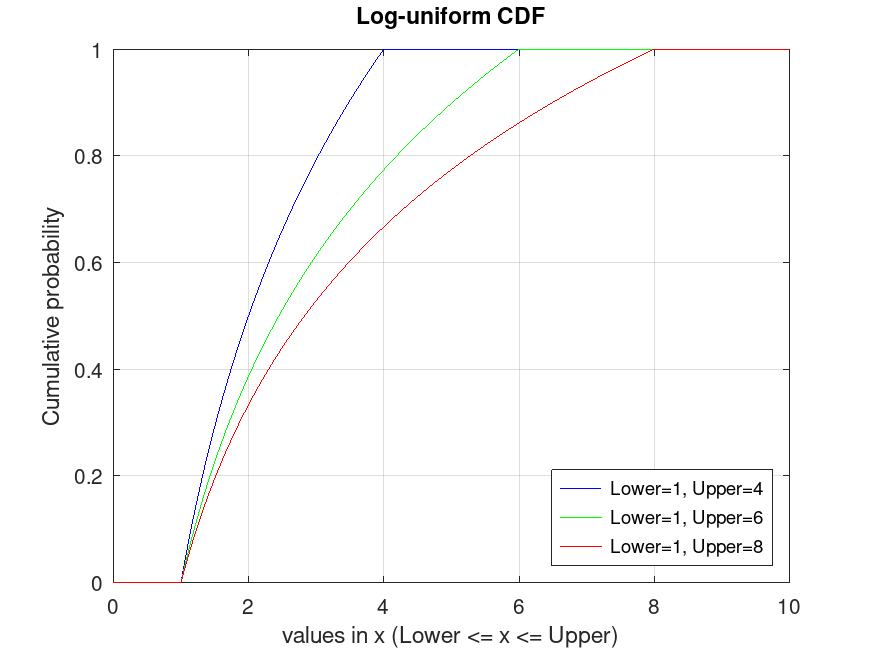
LoguniformDistribution: x = icdf (pd, p)
x = icdf (pd, p) computes the quantile (the
inverse of the CDF) of the probability distribution object, pd,
evaluated at the values in p.
Example: 1
## Plot various iCDFs from the Log-uniform distribution
p = 0.001:0.001:0.999;
pd1 = LoguniformDistribution (1, 4);
pd2 = LoguniformDistribution (1, 6);
pd3 = LoguniformDistribution (1, 8);
x1 = icdf (pd1, p);
x2 = icdf (pd2, p);
x3 = icdf (pd3, p);
plot (p, x1, "-b", p, x2, "-g", p, x3, "-r")
grid on
legend ({"Lower=1, Upper=4", "Lower=1, Upper=6", "Lower=1, Upper=8"}, ...
"location", "northwest")
title ("Log-uniform iCDF")
xlabel ("Probability")
ylabel ("values in x (Lower <= x <= Upper)")
## This demonstrates the inverse CDF (quantiles) for Log-uniform
## distributions, useful for finding values at specific probabilities,
## such as in Monte Carlo simulations.
|
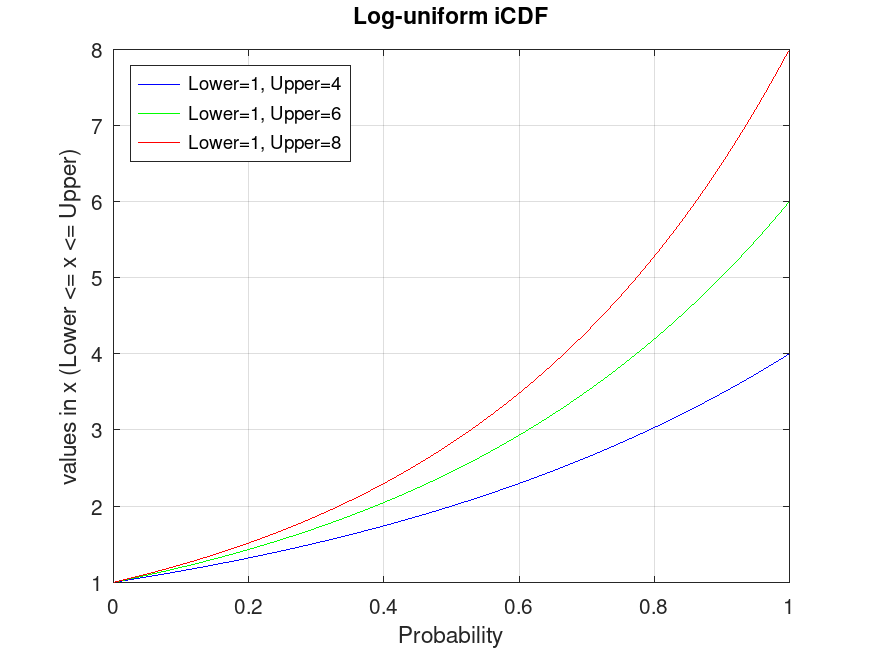
LoguniformDistribution: r = iqr (pd)
r = iqr (pd) computes the interquartile range of the
probability distribution object, pd.
Example: 1
## Compute the interquartile range for a Log-uniform distribution
pd = LoguniformDistribution (1, 10);
iqr_value = iqr (pd)
## Use this to calculate the interquartile range, measuring the spread
## of the middle 50% of the distribution on a log scale, helpful for
## robust statistics in skewed data.
iqr_value = 3.8451
|
LoguniformDistribution: m = mean (pd)
m = mean (pd) computes the mean of the probability
distribution object, pd.
Example: 1
## Compute the mean for different Log-uniform distributions
pd1 = LoguniformDistribution (1, 5);
pd2 = LoguniformDistribution (1, 10);
mean1 = mean (pd1)
mean2 = mean (pd2)
## This shows how to compute the expected value for Log-uniform
## distributions with different upper limits, representing the average
## value over the range.
mean1 = 2.4853
mean2 = 3.9087
|
LoguniformDistribution: m = median (pd)
m = median (pd) computes the median of the probability
distribution object, pd.
Example: 1
## Compute the median for different Log-uniform distributions
pd1 = LoguniformDistribution (1, 5);
pd2 = LoguniformDistribution (1, 10);
median1 = median (pd1)
median2 = median (pd2)
## Use this to find the median value, which is the geometric mean of
## the bounds, splitting the distribution into equal probability halves.
median1 = 2.2361
median2 = 3.1623
|
LoguniformDistribution: y = pdf (pd, x)
y = pdf (pd, x) computes the PDF of the
probability distribution object, pd, evaluated at the values in
x.
Example: 1
## Plot various PDFs from the Log-uniform distribution
x = 0.1:0.01:10;
pd1 = LoguniformDistribution (1, 4);
pd2 = LoguniformDistribution (1, 6);
pd3 = LoguniformDistribution (1, 8);
y1 = pdf (pd1, x);
y2 = pdf (pd2, x);
y3 = pdf (pd3, x);
plot (x, y1, "-b", x, y2, "-g", x, y3, "-r")
grid on
legend ({"Lower=1, Upper=4", "Lower=1, Upper=6", "Lower=1, Upper=8"}, ...
"location", "northeast")
title ("Log-uniform PDF")
xlabel ("values in x (Lower <= x <= Upper)")
ylabel ("Probability density")
## This visualizes the probability density function for Log-uniform
## distributions, showing the likelihood decreasing inversely with x.
|
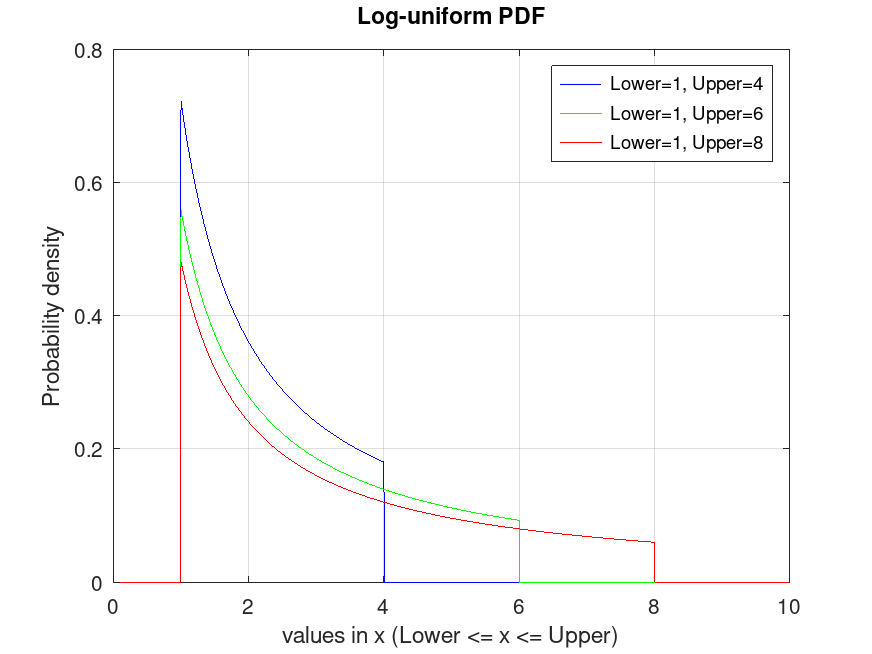
LoguniformDistribution: plot (pd)
LoguniformDistribution: plot (pd, Name, Value)
LoguniformDistribution: h = plot (…)
plot (pd) plots a probability density function (PDF) of the
probability distribution object pd.
plot (pd, Name, Value) specifies additional
options with the Name-Value pair arguments listed below.
| Name | Value | |
|---|---|---|
"PlotType" | A character vector specifying the plot
type. "pdf" plots the probability density function (PDF).
"cdf" plots the cumulative density function (CDF). | |
"Discrete" | A logical scalar to specify whether to
plot the PDF or CDF of a discrete distribution object as a line plot or a
stem plot, by specifying false or true, respectively. By
default, it is true for discrete distributions and false
for continuous distributions. When pd is a continuous distribution
object, option is ignored. | |
"Parent" | An axes graphics object for plot. If
not specified, the plot function plots into the current axes or
creates a new axes object if one does not exist. |
h = plot (…) returns a graphics handle to the plotted
objects.
Example: 1
## Create a Log-uniform distribution with fixed parameters Lower=1 and
## Upper=4 and plot its PDF.
pd = LoguniformDistribution (1, 4);
plot (pd)
title ("Fixed Log-uniform distribution with Lower=1 and Upper=4")
|
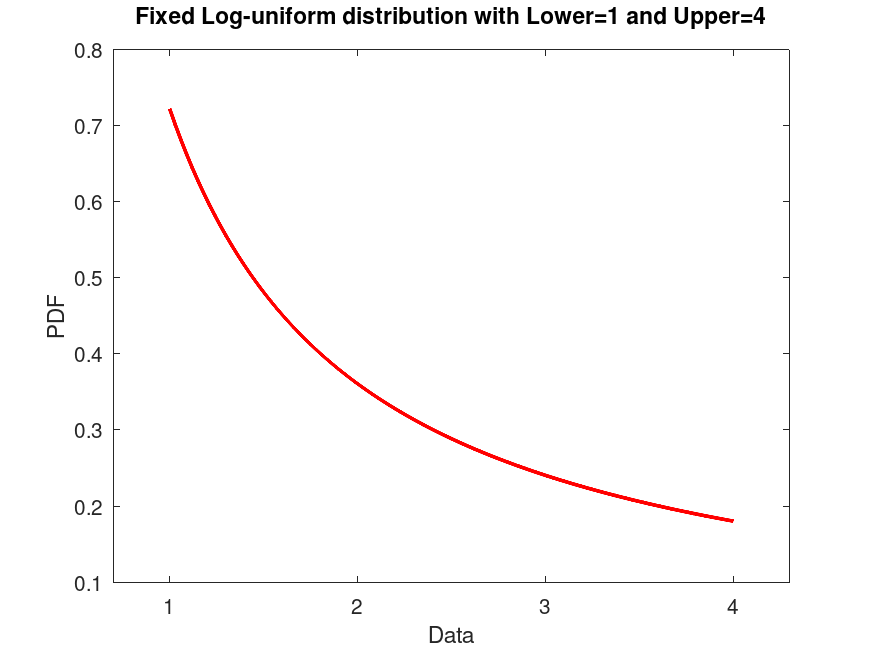
Example: 2
## Generate a data set of 100 random samples from a Log-uniform
## distribution with parameters Lower=1 and Upper=10. Plot its CDF.
rand ("seed", 21);
data = exp (unifrnd (log (1), log (10), 100, 1));
pd = LoguniformDistribution (1, 10);
plot (pd, "PlotType", "cdf")
title ("Log-uniform distribution with Lower=1 and Upper=10")
## Use this to visualize the CDF, useful for understanding cumulative
## probabilities in the distribution.
|
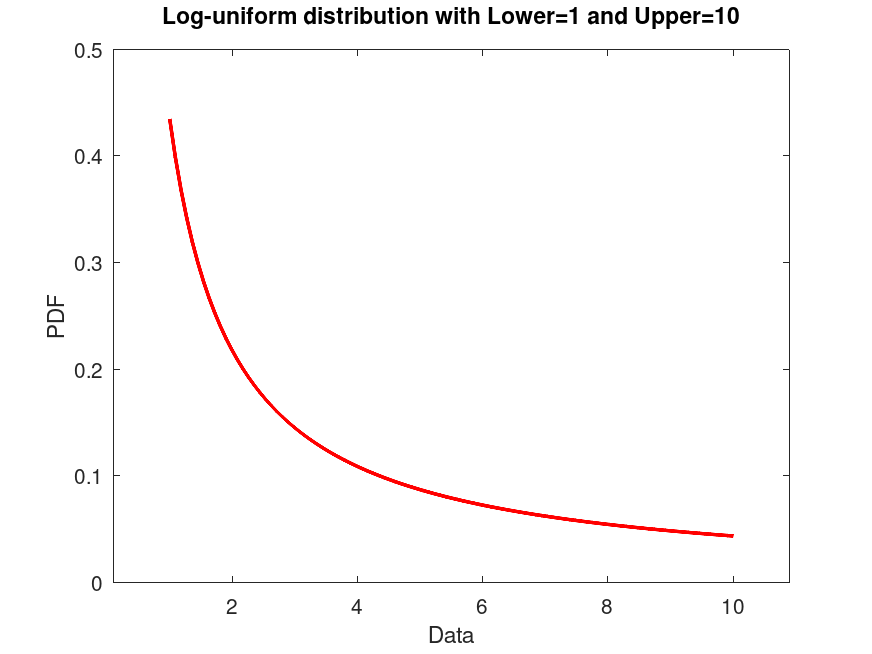
LoguniformDistribution: r = random (pd)
LoguniformDistribution: r = random (pd, rows)
LoguniformDistribution: r = random (pd, rows, cols, …)
LoguniformDistribution: r = random (pd, [sz])
r = random (pd) returns a random number from the
distribution object pd.
When called with a single size argument, random returns a square
matrix with the dimension specified. When called with more than one
scalar argument, the first two arguments are taken as the number of rows
and columns and any further arguments specify additional matrix
dimensions. The size may also be specified with a row vector of
dimensions, sz.
Example: 1
## Generate random samples from a Log-uniform distribution
rand ("seed", 21);
pd = LoguniformDistribution (1, 10);
samples = random (pd, 500, 1);
hist (samples, 50)
title ("Histogram of 500 random samples from Log-uniform(Lower=1, Upper=10)")
xlabel ("values in x (Lower <= x <= Upper)")
ylabel ("Frequency")
## This generates random samples from a Log-uniform distribution, useful
## for simulating data uniform on a log scale, like in power-law phenomena.
|
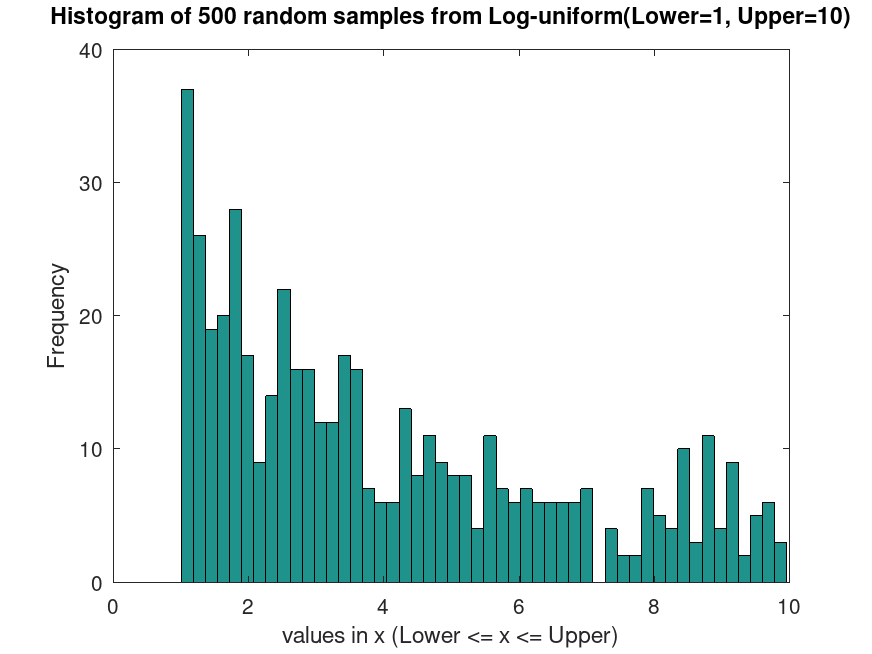
LoguniformDistribution: s = std (pd)
s = std (pd) computes the standard deviation of the
probability distribution object, pd.
Example: 1
## Compute the standard deviation for a Log-uniform distribution
pd = LoguniformDistribution (1, 10);
std_value = std (pd)
## Use this to calculate the standard deviation, measuring the variability
## in the distribution's values.
std_value = 2.4940
|
LoguniformDistribution: t = truncate (pd, lower, upper)
t = truncate (pd, lower, upper) returns a
probability distribution t, which is the probability distribution
pd truncated to the specified interval with lower limit,
lower, and upper limit, upper.
Example: 1
## Plot the PDF of a Log-uniform distribution, with parameters Lower=1
## and Upper=10, truncated at [2, 5] intervals. Generate 10000 random
## samples from this truncated distribution and superimpose a histogram scaled
## accordingly
rand ("seed", 21);
data_all = exp (unifrnd (log (1), log (10), 20000, 1));
data = data_all(data_all >= 2 & data_all <= 5);
data = data(1:7500);
pd = LoguniformDistribution (1, 10);
t = truncate (pd, 2, 5);
[counts, centers] = hist (data, 50);
bin_width = centers(2) - centers(1);
bar (centers, counts / (sum (counts) * bin_width), 1);
hold on;
## Plot histogram and truncated PDF
x = linspace (0.5, 5, 500);
y = pdf (t, x);
plot (x, y, "r", "linewidth", 2);
title ("Log-uniform distribution (Lower=1, Upper=10) truncated at [2, 5]")
legend ("Truncated PDF", "Histogram")
## This demonstrates truncating a Log-uniform distribution to a specific
## range and visualizing the resulting distribution with random samples.
|
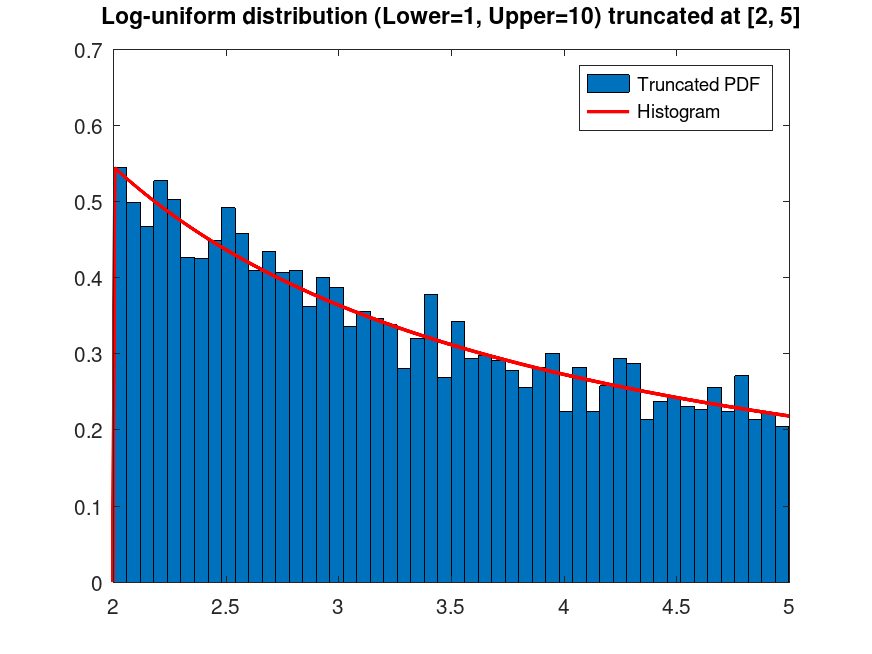
LoguniformDistribution: v = var (pd)
v = var (pd) computes the variance of the
probability distribution object, pd.
Example: 1
## Compute the variance for a Log-uniform distribution
pd = LoguniformDistribution (1, 10);
var_value = var (pd)
## Use this to calculate the variance, quantifying the spread of the
## values in the distribution.
var_value = 6.2200
|
Examples
pd_fixed = makedist ("Loguniform", "Lower", 1, "Upper", 10);
rand ("seed", 2);
data = random (pd_fixed, 5000, 1);
plot (pd_fixed)
hold on
hist (data, 50)
hold off
msg = "Log-uniform distribution with Lower = %0.2f and Upper = %0.2f";
title (sprintf (msg, pd_fixed.Lower, pd_fixed.Upper)) |
